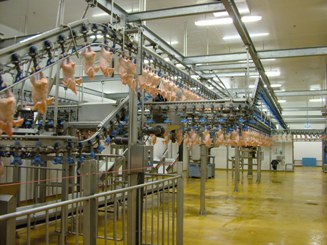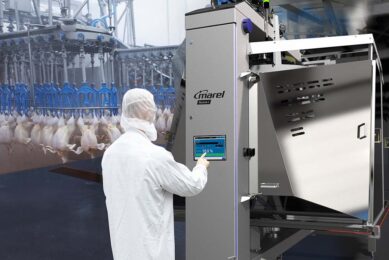Concrete sealant keeps the floor free from pathogens

Concrete floors in processing plants can be a major source of contamination. Bacteria can easily survive in the pores. Applying a sealant to the floor may significantly decrease the bacteria population.
By M. Singh, J.B. Hess, K. Macklin, S.F. Bilgili, and D.E. Conner, Department of Poultry Science, Auburn University, AL, USA,
Concrete is present in food industry facilities especially in flooring, walls and ceilings. During processing, concrete receives a great amount of organic matter. The organic matter in the poultry industry is a result of usual processing steps such as bleeding, scalding, feather-picking and eviscerating. This organic matter has the potential to serve as an initial source of nutrients to microorganisms, allowing them to colonise on and/or in concrete.
Concrete is a microporous, microstructure-sensitive construction material, and the pores in concrete are randomly sized, arranged, and connected. These pores form capillary systems in concrete allowing water and other substances to traffic freely in concrete structures. When liquids flow freely through concrete, they may serve as carriers in the transport of microorganisms such as bacteria. To understand and interpret the behaviour of a composite element such as concrete, knowledge of the characteristics of its components is necessary.
Eliminate chronic sources
Concrete is produced by the collective mechanical and chemical interaction of a large number of constituent materials. Disintegration of concrete due to cycles of wetting, freezing, thawing, drying, chemicals and the propagation of the resulting cracks is a matter of great importance for the food industry. The disintegration of concrete will serve as great attachment sites for bacteria to form niches. These niches will serve as permanent sources of contamination for whatever food is being processed. Contamination of food may occur from direct contact of food to concrete surfaces or indirect contact (water splashes during sanitation, staff shoes and clothes).
Concrete is produced by the collective mechanical and chemical interaction of a large number of constituent materials. Disintegration of concrete due to cycles of wetting, freezing, thawing, drying, chemicals and the propagation of the resulting cracks is a matter of great importance for the food industry. The disintegration of concrete will serve as great attachment sites for bacteria to form niches. These niches will serve as permanent sources of contamination for whatever food is being processed. Contamination of food may occur from direct contact of food to concrete surfaces or indirect contact (water splashes during sanitation, staff shoes and clothes).
Therefore, the food industry has put forth a great deal of effort on the reduction of bacterial niches and avoiding the formation of biofilms. There is no single action which will reduce or eliminate biofilms from industrial environments. Several actions must be taken collectively to prevent the formation of biofilms and eliminate these chronic sources of contamination. Given the structure of concrete, temperature, and humidity in a poultry processing environment, conditions are favourable for several bacteria (pathogenic and non-pathogenic) to survive and pose a potential threat to spread onto products leading to foodborne illnesses. Some of the most common pathogens to be concerned about in such environments are Listeria monocytogenes, Salmonella, and spore formers such as Clostridium and Bacillus.
Potential health hazard
Contamination by L. monocytogenes in raw chicken is high in comparison with other foods, which is a potential health hazard because of the chances of cross contamination to other foods in the home and the possibility of the microorganism surviving in processed chicken. In addition, raw chicken must be considered as one of the many sources of contamination to further processing facilities as the presence of Listeria spp. on incoming raw meat ingredients can work as a continuous source of contamination for other processing plants. There are several opportunities for this organism to spread and colonise in the industrial environment following its entrance in a processing and further processing poultry facility. Floors and drains have been implicated as the primary source of L. monocytogenes in poultry processing plants and the persistence of this microorganism in the hostile processing environment is enhanced by their ability to attach to surfaces and form biofilms. This unique survival property makes the presence of Listeria difficult to control and remove from processing environments. Because of the ubiquitous nature of the organism, it is important in a food processing operation to prevent contamination from L. monocytogenes and prevent recontamination of foods that are ready-to-eat [RTE] finished products.
Contamination by L. monocytogenes in raw chicken is high in comparison with other foods, which is a potential health hazard because of the chances of cross contamination to other foods in the home and the possibility of the microorganism surviving in processed chicken. In addition, raw chicken must be considered as one of the many sources of contamination to further processing facilities as the presence of Listeria spp. on incoming raw meat ingredients can work as a continuous source of contamination for other processing plants. There are several opportunities for this organism to spread and colonise in the industrial environment following its entrance in a processing and further processing poultry facility. Floors and drains have been implicated as the primary source of L. monocytogenes in poultry processing plants and the persistence of this microorganism in the hostile processing environment is enhanced by their ability to attach to surfaces and form biofilms. This unique survival property makes the presence of Listeria difficult to control and remove from processing environments. Because of the ubiquitous nature of the organism, it is important in a food processing operation to prevent contamination from L. monocytogenes and prevent recontamination of foods that are ready-to-eat [RTE] finished products.
Spores and vegetative cells
It has been well documented that spores exhibit a higher resistance than vegetative cells when exposed to a variety of chemical compounds and physical treatments. Sporulation allows the organisms protection from cross-linking agents such as glutaraldehyde, oxidising agents, phenols, formaldehyde, chloroform, octanol, alkylating agents such as ethylene oxide, iodine, and detergents, as well as pH and temperature extremes, and lytic enzymes such as lysozyme. The spore metabolic dormancy is undoubtedly one factor contributing to the survivability of these microbes during extended periods both in the absence of nutrients and hostile environments. When nutritive and environmental conditions become conducive, spores can germinate and return to a vegetative state, potentially causing serious problems to the food industry due to shelf life reduction and contamination of foods. Bacterial endospores can survive in the environment for an extended period of time, and are resistant to a wide-variety of treatments such as heat, desiccation, radiation, pressure, and chemicals.
It has been well documented that spores exhibit a higher resistance than vegetative cells when exposed to a variety of chemical compounds and physical treatments. Sporulation allows the organisms protection from cross-linking agents such as glutaraldehyde, oxidising agents, phenols, formaldehyde, chloroform, octanol, alkylating agents such as ethylene oxide, iodine, and detergents, as well as pH and temperature extremes, and lytic enzymes such as lysozyme. The spore metabolic dormancy is undoubtedly one factor contributing to the survivability of these microbes during extended periods both in the absence of nutrients and hostile environments. When nutritive and environmental conditions become conducive, spores can germinate and return to a vegetative state, potentially causing serious problems to the food industry due to shelf life reduction and contamination of foods. Bacterial endospores can survive in the environment for an extended period of time, and are resistant to a wide-variety of treatments such as heat, desiccation, radiation, pressure, and chemicals.
Significant reductions
Researchers at Auburn University’s Department of Poultry Science conducted studies to determine the probability of bacterial pathogens, including spore formers such as Bacillus subtilis and Clostridium perfringens to survive in tough environmental conditions usually encountered in concrete. Tests were conducted to determine the efficacy of a commercially available concrete sealant to reduce/eliminate Listeria monocytogenes, Salmonella spp., Bacillus subtilis, and Clostridium perfringens from the external and internal surfaces of miniature concrete blocks manufactured in the Food Safety Research laboratory at Auburn University.
Researchers at Auburn University’s Department of Poultry Science conducted studies to determine the probability of bacterial pathogens, including spore formers such as Bacillus subtilis and Clostridium perfringens to survive in tough environmental conditions usually encountered in concrete. Tests were conducted to determine the efficacy of a commercially available concrete sealant to reduce/eliminate Listeria monocytogenes, Salmonella spp., Bacillus subtilis, and Clostridium perfringens from the external and internal surfaces of miniature concrete blocks manufactured in the Food Safety Research laboratory at Auburn University.
Results from our Listeria challenge study on concrete blocks as shown in Table 1 indicated that the concrete sealant was effective in reducing survival populations by up to 1.7 log10 CFU/sq. cm on the external surface and 1.24 log10 CFU/sq. cm on the internal surface of the test blocks. These reductions are significant because although Listeria is present in the environment it is usually present in fairly low numbers in the poultry processing environments. Observations from the Salmonella challenge study as shown in Table 2 indicated a 3.78 log10 CFU/sq. cm reduction on the external surfaces while a 1.20 log10 CFU/sq. cm reduction was observed on the internal surfaces of the concrete blocks.
Reside in concrete
Furthermore, researchers at Auburn University also conducted challenge studies with spore forming bacteria that included B. subtilis and C. perfringens and observed reductions of up to 2.96 and 1.86 log10 CFU/sq. cm respectively on the external surfaces of concrete blocks. Recovery of spores of these pathogens from the internal surfaces of concrete blocks suggests the ability of the spores to penetrate through the microporous concrete and potentially reside in the concrete for a long period of time hence acting as a source of contamination at a later stage.
Furthermore, researchers at Auburn University also conducted challenge studies with spore forming bacteria that included B. subtilis and C. perfringens and observed reductions of up to 2.96 and 1.86 log10 CFU/sq. cm respectively on the external surfaces of concrete blocks. Recovery of spores of these pathogens from the internal surfaces of concrete blocks suggests the ability of the spores to penetrate through the microporous concrete and potentially reside in the concrete for a long period of time hence acting as a source of contamination at a later stage.
Results from the different timings of application indicate that a sealant that has the potential to penetrate the concrete pores may help reduce bacterial populations that are pre-existing in the concrete therefore being beneficial for previously existing as well as newly constructed processing plants.
Join 31,000+ subscribers
Subscribe to our newsletter to stay updated about all the need-to-know content in the poultry sector, three times a week. Beheer
Beheer








 WP Admin
WP Admin  Bewerk bericht
Bewerk bericht